QUADRAPHONIC MIXING
FOR A STAGE PLAY IN 1971
A query of how to do something technical led to what is believed to be the
first use of matrix quadraphonics for sound effects in a live stage play.
We had the ghostly voices coming from various directions, thunder rolling across the
auditorium, and other sound effects placed over the stage to match events on the stage.
The sound effects were quite effective.
Disclaimer: Since I have lost track of all of the participants in this play,
since many of them were minors at the time, and since I have no way to obtain publication
releases, I will not provide any details that could lead to identifying any person who had
contributed to this project.
Prologue: The query that led to the project:
A friend came to me in late 1970 with a technical question: Can five tape recorders be
synchronized?
I began to think on the complexity of this question, including the following facts:
- They wanted sound effects to come from at least 5 different directions in the
auditorium.
- They were talking about the Wollensak mono tape recorders that most schools had in the
1960s.
- Those Wollensak tape recorders had no synchronization capabilities.
- I had been experimenting with the Hafler (Dynaco) quadraphonic system earlier in the
year.
- Several ideas came to mind:
- Use one tape recorder and switch among several speakers. This would require switch
position cues for each sound.
- Switching speakers also required as many speakers as the number of directions the
sounds need to come from.
- Turn on a separate tape recorder for each wanted sound direction.
- Use a quadraphonic system and recording.
We decided to use the Hafler quadraphonic system using a stereo tape recorder, a stereo
amplifier, four speakers, and lots of speaker wire.
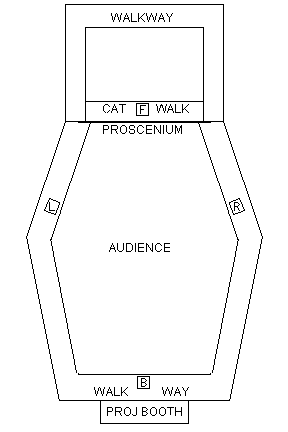
The Auditorium
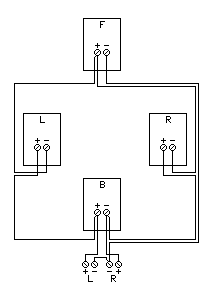
Hafler Speaker Matrix
The Auditorium we Used
This was a typical high-school auditorium except that it was designed with safety in
mind.
- All levels are accessed by stairways, not ladders.
- A raised walkway goes around the entire outside of the stage and audience areas.
- The walkway is at the level a balcony would be at if one existed.
- Doors with closers connect the stage walkway to the audience area walkway.
- A catwalk goes directly behind the proscenium arch.
- A stairway goes up to the beam room above the ceiling where the spotlights are.
- Actors or choir singers can be on the walkways and interact with the audience.
- The aisles at the ends of the rows of seats are under the walkways in the audience
area.
- The projection booth has a door to the walkway and a short stairway.
- The lighting console is in the projection booth.
- The lighting patchbay is under the walkway to the left of the stage.
- The cyclorama is between the stage and the rear walkway.
- A walkway is also at the stage level behind the cyclorama under the raised walkway.
Building the Quadraphonic Speaker Setup
This is how the quadraphonic speaker layout was assembled in the auditorium:
- The speakers are F (front), L (left), R (right), and B (back).
- The speaker locations F, L, R, and B are marked on the map of the auditorium.
- The speakers were large speakers made for auditorium use.
- The L, R, and B speakers faced the audience.
- Speakers were raised over walkway parapets by setting them on pairs of wooden chairs.
- The speakers were set so the high-frequency drivers played over the tops of the
parapets.
- The F speaker faced downward through the metal catwalk lattice.
- There was enough room for workers to pass on one side of each speaker.
- A zip-cord pair of 18-gage wire was run all the way around the walkway and catwalk.
- The wires were connected to the speakers as shown in the wiring diagram.
- The unused wire in the pair running down the left side was left disconnected.
- Polarity is important when connecting speakers. Polarity was as shown in the diagram.
- The terminals shown at the bottom of the diagram are the amplifier output terminals.
- The amplifier used had common negative outputs (necessary for this system).
- The stereo tape recorder line outputs fed the amplifier.
- The tape recorder and amplifier were in the projection booth.
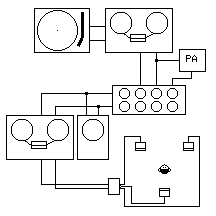
Encoding System
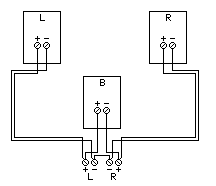
Monitor Speakers
Building the Encoding Setup
The encoding equipment consisted largely of equipment I already had, plus borrowed tape
equipment:
- Panpots are much easier to use.
- My concept of using a mixer to encode was born.
The Test Tape
I made a test tape containing the following tracks:
- Mono sweep test tones.
- Sweep test tones in the back channel.
- Thunder recorded from a stereo record
- Two more repeats of this thunder
- The same thunder recorded rotated a quarter turn to the right.*
- Two more repeats of this thunder
- The Ballad of John and Yoko (The Beatles) rotated a quarter turn to the right.*
* This quarter-turn rotation was accomplished by:
- Putting the original left channel in the front (in phase in both channels) and
- Putting the original right channel in the back (reversing phase of left channel feed).
- This put material that on the record is centered between the speakers on the right.
I used this tape to set up and adjust the settings on the amplifier.
The Play
Ondine is a play written in 1938 by Jean Giraudoux about Hans and Ondine. Hans, a knight,
meets, falls in love with, and marries Ondine, a water-sprite disobeying her purpose. The
marriage has tragic consequences.
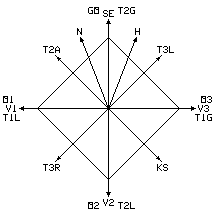
Encoding pan plot
Encoding the Sound Effects
I was given a half-track mono tape containing the sounds they wanted to use in the play.
I first read the parts of the script having the sounds and voices and a list of the desires
the director had for where to place the sounds. He wanted some of the voices to intentionally
come from the wrong directions (different from the location of the visible entity) for
effect.
I made my first ever quadraphonic pan plot that day. I still use these pan plots for surround
recordings today. But I no longer put diamonds or other shapes showing speaker locations
in them. I usually use a circle to show the entire sound field.
When I positioned the King of the Sea (KS), I was thinking of the out-of-phase
"hole" the theorists said existed there. I wanted the position to be indistinct.
But actually trying this positioning with the equipment showed that the "hole" was
not the problem the experts claimed. The image was stable where I put it.
I still have those pan plots. But I wrote other things about the play on the backs of the
pages the plots were on and the ink bled through. So it was easier to make a new one than to
try to separate the wanted material from the unwanted.
Here is how each sound was encoded:
| Sounds | Identity | Encoding | Visible Item |
| O1 V1 | Ondine's 1st Sister | left side (straight left) | stage left |
| O2 V2 | Ondine's 2nd Sister | center back | center stage |
| O3 V3 | Ondine's 3rd Sister | right side (straight right) | stage right |
| H | A head seen in a window | slightly right of center stage | center stage |
| N | A naiad (spirit) seen in a window | slightly left of center stage | center stage |
| KS | The King of the Sea (known as The Old One) | right back | center stage |
| SE | Various onstage sound effects (e.g. falling armor) | center stage | center stage |
| GO | A gong struck by a servant | center stage | center stage |
| T1L |
Thunder recorded on two tracks for an overhead rolling effect
T1L is a few seconds ahead of identical T1G |
left side |
Lighting cue onstage |
| T1G |
right side |
| T2L |
Thunder recorded on two tracks for an overhead rolling effect
T2L is a few seconds ahead of identical T2G
T2A a different thunder track starting one second before the end of T2G |
center back |
Lighting cue onstage |
| T2G |
center front |
| T2A |
left front |
| T3L |
Thunder taken from a stereo sound effect record
T3L and T3R is a repanned stereo recording |
right front |
Lighting cue onstage |
| T3R |
left back |
The thunder tracks were made by recording the L (leading) track on one track of the half-track
recorder and the G (lagging) track on the other track on the half-track. Then these tracks were
simultaneously played through the encoder set to the pan positions in the table and recorded on
the quarter-track recorder.
On the original tape, T2A was intended to be T3L, but that changed (below).
After the tape was completed, the sound man spliced leader tape in between the sound
effects so the tape operator knew when to stop the tape after each effect.
The Dress Rehearsal
One glitch developed during the dress rehearsal. T2L and T2A (originally T3L) were left as one
piece of tape because the sound man could not find the cut point.
The fade out of T2G led into T2A with no clear break.
I created a new strip of tape with the T3L and T3R tracks from a stereo record I have.
The sound man then spliced it in with more leader tape.
The Performances
The performances worked quite well. The sound effects were quite effective. Only one
glitch occurred with the sound: The tape operator accidentally hit fast-forward instead
of play and skipped one sound effect for one performance.
After the Play
I had wanted to make a copy of the tape after the play was over for evidence that I
had done this, but I was told that, because the voices of minor students were on the
tape, there would be a legal problem with me keeping copies of any of the materials. So I
have no record (other than my pan plots and the play program with my name in it) to show
that it ever happened.
I can't even show the auditorium to anyone anymore. The building was torn down and
a computer center for the university was built there.
This play took place in early 1971. I believe it was the very first use of matrix
quadraphonics in a live theater presentation.




